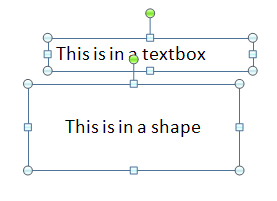DrawingML Text
Wordprocessing and spreadsheet documents contain text as a fundamental characteristic of their structure. Create a document and begin entering text, and the text will flow in a familiar and well-defined manner. Each of these document types can also contain text of a more graphic, specialized nature, inserted into a text box or shape. The text box or shape can be located and styled apart from the other text in the document. For each of these document types, the graphical text is inserted as a drawing is inserted, in a specialized namespace covering drawingML for that document type. See Positioning within a Spreadsheet Document and Positioning within a Word Processing Document. A presentation document is not so fundamentally text-oriented, and all text within a presentation must be within a text box or shape. Its placement is defined within the main drawingML specification and namespace.
Although the way in which the text is placed within the document varies from document type to document type, the definition of the text itself remains the same. Text within a text box is really just a specialized shape containing text. See Shapes - Text. Every shape contains a set of non-visual properties for the canvas within the <nvSpPr> element. Within the <nvSpPr> element is <cNvSpPr>, containing a set of non-visual properties for the shape. That element has an attribute txBox, which can be either true or false. If true, then the shape is a text box. If false, or if the attrubute is not present, then the shape is not specifically a text box. In fact, though, there is little difference between a text box and a shape with text. For presentations and spreadsheets the geometry (<a:prstGeom>) can be omitted. But it can and often is set with a value of rectangle (<a:prstGeom prst="rect">).
Below is a sample containing first a text box and then a shape with text. Both are shapes within a <p:sp> element. The text box has the attribute txBox="1". It also has no <p:style> element, though it could. For the shape, the style information within the <p:style> element is overridden by the lack of line and fill as specified in the <a:prstGeom> element.

